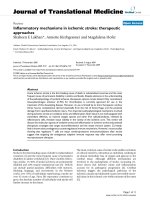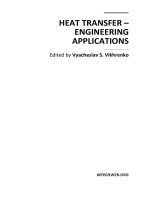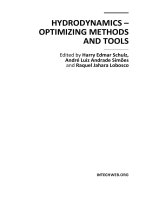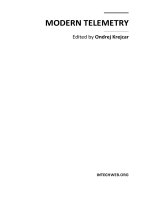Acute Ischemic Stroke Part 1 potx
Bạn đang xem bản rút gọn của tài liệu. Xem và tải ngay bản đầy đủ của tài liệu tại đây (497.3 KB, 18 trang )
ACUTE ISCHEMIC STROKE
Edited by Julio César García Rodríguez
Acute Ischemic Stroke
Edited by Julio César García Rodríguez
Published by InTech
Janeza Trdine 9, 51000 Rijeka, Croatia
Copyright © 2011 InTech
All chapters are Open Access distributed under the Creative Commons Attribution 3.0
license, which allows users to download, copy and build upon published articles even for
commercial purposes, as long as the author and publisher are properly credited, which
ensures maximum dissemination and a wider impact of our publications. After this work
has been published by InTech, authors have the right to republish it, in whole or part, in
any publication of which they are the author, and to make other personal use of the
work. Any republication, referencing or personal use of the work must explicitly identify
the original source.
As for readers, this license allows users to download, copy and build upon published
chapters even for commercial purposes, as long as the author and publisher are properly
credited, which ensures maximum dissemination and a wider impact of our publications.
Notice
Statements and opinions expressed in the chapters are these of the individual contributors
and not necessarily those of the editors or publisher. No responsibility is accepted for the
accuracy of information contained in the published chapters. The publisher assumes no
responsibility for any damage or injury to persons or property arising out of the use of any
materials, instructions, methods or ideas contained in the book.
Publishing Process Manager Vana Persen
Technical Editor Teodora Smiljanic
Cover Designer InTech Design Team
First published January, 2011
Printed in Croatia
A free online edition of this book is available at www.intechopen.com
Additional hard copies can be obtained from
Acute Ischemic Stroke, Edited by Julio César García Rodríguez
p. cm.
ISBN 978-953-307-983-7
free online editions of InTech
Books and Journals can be found at
www.intechopen.com
Contents
Preface IX
Chapter 1
Diaschisis, Degeneration, and
Adaptive Plasticity After Focal Ischemic Stroke 1
Bernice Sist, Sam Joshva Baskar Jesudasan and Ian R. Winship
Chapter 2
Excitotoxicity and Oxidative
Stress in Acute Ischemic Stroke 29
Ramón Rama Bretón and Julio César García Rodríguez
Chapter 3
Neuro-EPO by Nasal Route
as a Neuroprotective Therapy in Brain Ischemia 59
Julio César García Rodríguez and Ramón Rama Bretón
Chapter 4
Dysphagia and Respiratory
Infections in Acute Ischemic Stroke
Claire Langdon
79
Chapter 5
Serum Lipids and Statin Treatment During Acute Stroke 101
Yair Lampl
Chapter 6
Endovascular Management of Acute Ischemic Stroke 121
Stavropoula I. Tjoumakaris, Pascal M. Jabbour, Aaron S. Dumont,
L. Fernando Gonzalez and Robert H. Rosenwasser
Chapter 7
Microemboli Monitoring in Ischemic Stroke
Titto Idicula and Lars Thomassen
Chapter 8
Intracranial Stenting for Acute Ischemic Stroke 157
Ahmad Khaldi and J. Mocco
Chapter 9
Surgical Treatment of Patients with
Ischemic Stroke Decompressive Craniectomy 165
Erion Musabelliu, Yoko Kato,
Shuei Imizu, Junpei Oda and Hirotoshi Sano
145
VI
Contents
Chapter 10
Understanding and Augmenting
Collateral Blood Flow During Ischemic Stroke 187
Gomathi Ramakrishnan, Glenn A. Armitage and Ian R. Winship
Chapter 11
Does Small Size Vertebral or
Vertebrobasilar Artery Matter in Ischemic Stroke?
Jong-Ho Park
Chapter 12
Hyperbaric Oxygen for Stroke 225
Ann Helms and Harry T. Whelan
213
Preface
We’ve arrived at the second decade of the XXI century of the modern era with 7 billion
human beings on our planet. Average life expectancy is 69 years of age, but for the
industrialized countries it stands at 80 years, while for the called developing countries and
for those denominated as less developed countries is only of 67 and 57 years
respectively. With this overview of the world’s population ages, the illness vascular
brain increases gradually in the industrialized countries. Among them, it is the stroke
that is of more incidences in the population. It is the third leading cause of death and
the most common cause of disability. Indeed, stroke is a big global health problem
affecting millions of people every year. This whole health problem has been
increasingly growing and has not only negative impact in the labor productivity –
such as in health expenses of, being repealed many human resources and financial
with a relatively low impact; but also in the prevention and in the recovery of the
patients.
In this somber panorama, it would be necessary to wonder: How can the
neurosciences contribute in the XXI century? Indeed, significant progress has been
made on stroke molecular aspects and neuroprotection in acute phase of this disease.
This information is scattered throughout the literature in original research papers,
reviews, and some recently edited books. However, until now there hasn't been a book
which summarizes in a comprehensible way, for the specialized readers as well as for
the ones simply interested on the topic – the main achieved advances and challenges
outlined in the preclinical research, the diagnosis, and treatment of the stroke.
This book is not only addressed at students and under-graduate and postgraduate
professors, avid to know and to fertilize with new knowledge, but it also seeks to be
an useful tool to investigators, doctors, nursing, occupational therapist,
physiotherapist, family members, and social workers that professionally fight against
this neurodegenerative wants.
For the thematic organization of this book, we have thought of exposing the reader the
following order: the physiopathology of the illness, those more outstanding aspects of
the preclinical research, the different treatments, and to conclude, the complications of
the acute ischemic stroke. In a very brief synthesis, we can say that: Chapter 1
describes the pathophysiology that leads to expansion of the infarct into surrounding
X
Preface
peri-infarct tissue, diaschisis and degeneration in distal but anatomically connected
regions, and the adaptive changes that occur distal to the infarct after focal stroke.
Chapter 2 explains the molecular aspects of the exitotoxicity and oxidative stress in
acute ischemic stroke (AIS). Chapter 3 explains a novel preclinical neuroprotective
therapy in AIS using Neuro-EPO by nasal way. Chapter 4 outlines the association of
dysphagia and other risk factors in the development of respiratory infections in AIS
patients. Chapter 5 describes the involvement of serum lipids and Statin treatment
during AIS. Chapter 6 describes the endovascular management of AIS. Chapter 7
explains the microemboli monitoring in AIS. Chapter 8 provides a cursory review each
of the major established methods of AIS recanalization therapy, followed by a detailed
review of intracranial stenting. Chapter 9 discusses the surgical treatment of AIS
patients using decompressive craniectomy. Chapter10 makes a critical revision of our
understanding of the dynamics, persistence, and regulation of collateral blood flow
and expanding on studies evaluating the mechanisms and efficacy of collateral
therapeutics and improved strategies for AIS. In Chapter 11, the authors make a
critical analysis and explain the role of both vertebral or vertebrobasilar size in AIS,
and finally, Chapter 12 deals with the hyperbaric oxygen for Stroke.
This Editor expects that the efforts carried out in this book to integrate and to
consolidate the molecular, clinical and therapeutic knowledge of AIS, and the
neuroprotection in this illness will contribute in accelerating the search of more
effective and safer therapeutic alternatives for the more than five million people that
currently suffer AIS in our planet.
I truly want to express my gratitude and my personal satisfaction to all the authors,
other highly qualified people, and real experts in their field; that have worked in this
book preparation.
Prof. Julio César García Rodríguez
Life Science and Nanosecurity, Scientific Advisor’s Office, State Council,
Cuba
1
Diaschisis, Degeneration, and
Adaptive Plasticity After Focal Ischemic Stroke
Bernice Sist, Sam Joshva Baskar Jesudasan and Ian R. Winship
Centre for Neuroscience and Department of Psychiatry, University of Alberta,
Canada
1. Introduction
Focal stroke refers to sudden brain dysfunction due to an interruption of blood supply to a
particular region of the brain. An ischemic stroke (~80% of focal strokes) occurs due to a
blockage of a blood vessel, typically by a blood clot, whereas a haemorrhagic stroke results
from rupture of a cerebral blood vessel and the resulting accumulation of blood in the brain
parenchyma. Symptoms of stroke will vary depending on the size and location of the tissue
damaged by the reduced blood flow (the infarct), but common symptoms include sudden
weakness of the limbs or face, trouble speaking or understanding speech, impaired vision,
headache and dizziness. According to the World Health Organization (WHO), more than 15
million people suffer a stroke each year, of which five million people will die. Stroke is a
leading cause of chronic adult disability worldwide, and the majority of those who survive
their stroke (more than five million people per year) are left with permanent sensorimotor
disabilities, which may include loss of strength, sensation, coordination or balance (with the
nature and severity of disability depending on the location and size of the lesion).
Despite the significant societal and personal cost of stroke, treatment options remain
limited. Currently, only recombinant tissue-type plasminogen activator (rtPA), a serine
proteinase, has proved effective in treating ischemic stroke in clinical trials (NINDS, 1995).
Thrombolysis after rtPA administration occurs as a result of plasminogen being converted
to plasmin by rtPA. The plasmin then participates in the degradation of fibrin to restore
blood flow to territories downstream of the occlusion. Unfortunately, few patients are
treated with rtPA, in part due to it short therapeutic window of 4.5 hours (relative to delays
in symptom recognition, transport, and triaging) after ischemic onset (Lansberg et al., 2009;
Kaur et al., 2004; Clark et al., 1999; Del Zoppo et al., 2009). Moreover, rtPA is ineffective for
many patients treated within its therapeutic window, particularly with respect to middle
cerebral artery occlusion (MCAo), the most common cause of focal ischemic stroke (Kaur et
al., 2004; Seitz et al., 2011). Given the limited treatment options for stroke, an improved
understanding of its pathophysiology and the brains endogenous mechanisms for
neuroprotection, brain repair and neuroanatomical rewiring is important to developing new
strategies and improving stroke care.
While death and disability due to stroke can be predicted based on the size and location of
the infarct, damage due to stroke extends beyond the ischemic territories. Moreover, while
treatment options remain limited, partial recovery after stroke occurs due to adaptive
changes (plasticity) in brain structure and function that allow uninjured brain regions to
2
Acute Ischemic Stroke
adopt the function of neural tissue destroyed by ischemia (Winship and Murphy, 2009; C.E.
Brown and Murphy, 2008). While pathological and adaptive changes that occur in periinfarct cortex have been well characterized, less research has examined adaptive and
maladaptive changes distal to the infarct. In this chapter, we will review the
pathophysiology that leads to expansion of the infarct into surrounding peri-infarct tissue,
diaschisis and degeneration in distal but anatomically connected regions, and the adaptive
changes that occur distal to the infarct after focal stroke.
Infarct Growth
Necrosis
Remote Dysfunction
Apoptosis
Adaptive Plasticity
Peri-Infarct Depol
PeriInflammation
Axonal Degeneration
Secondary Damage
Diaschisis
Unmasking
Enhanced NMDA, LTP
Neuroanatomical Remodeling
Ischemia
Functional Remapping
Minutes
Hours
Days
Weeks
Months
Fig. 1. Timeline of stroke-induced degeneration, dysfunction and adaptive plasticity. During
ischemia, several processes lead to development of an infarct core and expansion of this core
into penumbral tissue (grey bars). Metabolic failure in the core of the ischemic territory
leads to rapid and irreversible cell death (necrosis), while inflammation and peri-infarct
depolarizations can induce delayed cell death (through apoptosis) in cells in the penumbra
over the following days and weeks. Focal stroke can also induce degeneration and
dysfunction in regions far from the infarct (blue bars). Brain dysfunction distal to the stroke
(diaschisis) can appear soon after ischemia and persist for weeks, and includes changes in
blood flow, metabolism, and altered inhibitory neurotransmission remote from the infarct.
Similarly, remote to the site of injury, axons from neurons in the infarct core degenerate,
inducing inflammation that can trigger secondary damage and atrophy in structures with
neuroanatomical links to the infarct. Finally, adaptive plasticity induced by the stroke can
occur immediately following ischemia and persist for months (red bars). Functional
unmasking of existing connections can lead to rapid redistribution of some function lost to
the infarct, and changes in glutamatergic transmission and long-term potentiation have been
reported in peri-infarct cortex and beyond in the first week after stroke. Neuroanatomical
rewiring to compensate for lost connections starts days after ischemia and persists for
months, allowing functional representations lost to stroke to remap to new locations in the
weeks and months after this initial insult.
Diaschisis, Degeneration, and Adaptive Plasticity After Focal Ischemic Stroke
3
2. Mechanisms of cell death and infarct growth after ischemic stroke
At the centre of the stroke, the “ischemic core”, brain damage is fast and irreversible as
reduced blood flow leads to the activation of proteolytic enzymes, degradation of the
cytoskeleton, cytotoxic swelling, and peroxidation of membrane lipids (Witte et al., 2000).
As blood flow within the core drops below 20% of normal flow rates, metabolic failure leads
to anoxic depolarization and activation of the “ischemic cascade” that triggers neuronal
death beginning within minutes of ischemic onset (Dirnagl et al., 1999; Hossmann, 1994;
Witte et al., 2000). Reduced blood flow decreases delivery of oxygen and glucose to the
brain, which leads to reduced production of adenosine triphosphate (ATP) and failure of
energy dependent membrane receptors, ion channels and ionic pumps. These failures lead
to collapse of transmembrane potential as ions such as sodium (Na+), potassium (K+) and
calcium (Ca2+) flow freely down their concentration gradients, leading to anoxic
depolarization and the release of additional excitatory neurotransmitters (primarily
glutamate). The resulting excitotoxicity is potentiated by the disruption of energy dependent
glutamate reuptake from the synaptic cleft, and the ensuing activation of the glutamatergic
N-methyl-D-amino (NMDA) receptor and the alpha-amino-3-hydroxy-5-methyl-4-isoxazolepropionic acid (AMPA) receptor lead to further depolarization and excitotoxicity. Water
begins to enter the cells in response to change in ion concentrations, producing cytotoxic
oedema, a pathophysiological marker of ischemia.
Intracellular increases in Ca2+ concentration are particularly important regulators of cell
death in the ischemic core due to the role Ca2+ plays as a second messenger. Ca2+increases
activate multiple signalling pathways that contribute to cell death, including enhancing the
production of nitric oxide (NO). NO is an intracellular messenger important for the normal
physiology of an organism, with a well-characterized role in regulating circulation (Huang,
1994; Dirnagl et al., 1999). NO production is regulated by nitric oxide synthase (NOS), a Ca2+
dependent enzyme. Following ischemia, increased activation of NOS can lead to neurotoxic
levels of NO (A.T. Brown et al., 1995; Dirnagl et al., 1999; Danton and Dietrich, 2003). During
initial stages of ischemia, NO produced by endothelial NOS triggers arterial dilation near
the region of occlusion, thereby increasing blood flow and increases the chance of survival
of the penumbra. However, NO can react with a superoxide anion to form the highly
reactive species peroxynitrite, which can react with and damage virtually any cellular
component (Mergenthaler et al., 2004). Increases in NO can initiate cell death by inducing
lipid oxidation chain reactions, which disrupt the lipid membranes of the mitochondria
(Burwell and Brookes, 2008), or by causing energy failures by acting as an electron acceptor
and thereby disrupting cellular respiration in the mitochondria (Bolaños et al., 1997; Brookes
et al., 1999; Burwell and Brookes, 2008; Dirnagl et al., 1999). Moreover, these reactive species
lead to peroxidation of the plasma, nuclear, and mitochondrial membranes, inducing DNA
damage and cell lysis. Beyond their direct effects on cell death, increased levels of reactive
oxygen and nitrogen species also induce release of pro-inflammatory factors from immune
cells, leading to inflammation and expansion of the stroke core (discussed further in Section
2.2) (Lai and Todd, 2006; Jin et al., 2010; Vila et al., 2000, 2003).
Surrounding the stroke core is a band of tissue referred to as the penumbra, in which blood
flow is partially preserved due to redundant collateral circulation. While this tissue is
somewhat ischemic, neurons here can be saved from death by reperfusion or
neuroprotective treatments soon after ischemic onset. The brain maintains independent
thresholds for functional integrity and structural integrity, thereby keeping a gradient of cell
4
Acute Ischemic Stroke
viability after ischemic insults. The threshold for functional integrity and that of structural
integrity are governed by two key factors: the residual flow rate of blood and duration of
reduced flow (Heiss and Graf, 1994). Since the threshold for functional integrity is higher
than that for structural integrity, the neurons in the penumbra are electrically silent but still
able to maintain ion homeostasis and structural integrity (Astrup et al., 1981; Ferrer and
Planas, 2003; Heiss and Graf, 1994; Symon, 1975; Hossmann, 1994). However, viability in the
penumbra is variable and time dependent, and a number of processes lead to cell death and
expansion of the infarct core into the penumbra. Three of these factors, peri-infarct
depolarizations, inflammation, and apoptosis, are discussed below.
2.1 Peri-infarct depolarizations
Excitotoxicity and anoxic depolarizations caused by ischemia increase extracellular glutamate
and potassium levels in the stroke core, which may then diffuse into penumbral regions and
trigger depolarization of the resident neurons and glia (Mergenthaler et al., 2004). A
propagating wave of depolarization moving away from the core is initiated and places
additional stress on the metabolically compromised cells in the penumbra. These
depolarizations can occur several times per hour during acute stroke (Busch et al., 1996; Wolf
et al., 1997). Since there are fluctuations in blood flow which compromise oxygen and glucose
supply, depolarizations within the peri-infarct cortex contribute to energy failure and cell
death, leading to the growth of the infarct core over time (Back et al., 1996). Recent data from
animal models suggests that ischemic depolarizations are accompanied by intracellular Ca2+
accumulation and a loss of synaptic integrity (Murphy et al., 2008). Murphy et al. (2008)
demonstrated that ischemic depolarizations and increases in intracellular calcium were
glutamate receptor independent and suggested that these depolarizations were the major ionic
event associated with the degeneration of synaptic structure early after ischemic onset.
Notably, persistent depolarizations resembling anoxic depolarization and transient
depolarizations resembling recurrent peri-infarct depolarizations emerge not only in cortex,
but also occur in striatal gray matter, suggesting that infarct expansion due to peri-infarct
depolarization extends beyond the cortex (Umegaki et al., 2005).
2.2 Inflammation and infarct growth
Inflammation is a non-specific physiological response to infection or injury. The central
nervous system is often labeled as "immune privileged" due to the presence of a blood brain
barrier that separates it from the periphery and prevents entry of most infectious materials
into the brain. However, inflammation after brain injury is characterized by the infiltration
and proliferation of immune cells in an attempt to eliminate cellular debris and pathogens,
and the secretion of chemokines and pro- and/or anti-inflammatory cytokines. After stroke,
the inflammatory response contributes to cell death and infarct growth for days after
ischemic onset (Dirnagl et al., 1999). Leukocytes, monocytes, neurons, and glial cells
(microglia and astrocytes) all participate in the inflammatory response to stroke. During
ischemia, leukocytes aggregate and adhere to the vascular endothelium, in part due to
increased release of chemokines such as monocyte chemo attractant protein 1 (MCP1) and
adhesion molecules such as selectins in ischemic territories (Danton and Dietrich, 2003;
Mergenthaler et al., 2004). Following ischemia, endothelial cells increase their expression of
selectin, which promotes cellular interactions with leukocytes and aggregates of leukocytes
that accumulate platelets and fibrin and thereby occlude vessels, reduce perfusion and
contribute to the expansion of the infarct (Ritter, 2000; Danton and Dietrich, 2003).
Diaschisis, Degeneration, and Adaptive Plasticity After Focal Ischemic Stroke
5
Glial cells are major contributors to post-stroke inflammation. As the resident immune cells
of the brain, microglia serve to monitor the brain microenvironment for injury or infection.
After stroke, microglia become activated and migrate to the stroke penumbra. Therein, they
assume an activated morphology and participate (along with leukocytes, neurons, and
astrocytes) in modulating inflammation through the secretion of pro- and anti-inflammatory
cytokines.
Cytokines are small glycoproteins and able to trigger multiple signaling pathways relevant
to cell death. Cytokines are important mediators of apoptosis (programmed cell death)
during stroke. In the hours following stroke, microglia transform from surveying the
microenvironment in a ramified “resting state” into an amoeboid phagocytotic state,
scavenging for debris and secreting cytotoxic and pro-inflammatory factors such as
interleukin-1 (IL-1), interleukin-6 (IL-6) and tumor necrosis factor alpha (TNF-α) (Danton
and Dietrich, 2003; J.J. Legos et al., 2000; E. Tarkowski et al., 1999). Within the first 24 hours
after stroke, amoeboid microglia and macrophages expressing high levels of interleukin-1
beta (IL-1β) accumulate at the border of the infarct area (Clausen et al., 2008; Mabuchi et al.,
2000). The interleukin-1 family of cytokines has multiple members that mediate
degeneration following ischemic stroke. Evidence for the importance of interleukin-1 alpha
(IL-1α) and IL-1β has been confirmed by studies that demonstrate that deleting both
cytokines can reduce infarct volume (Boutin et al., 2001). IL-1α is an important modulator of
cerebrovascular inflammation and induces activation of endothelial cells and expression of
adhesion molecules, allowing leukocytes and neutrophils to enter the central nervous
system and increase secretion of pro-inflammatory cytokines and production of reactive
oxygen species (Jin et al., 2010; Thornton et al., 2010). TNF-α released by immune cells binds
to the TNF type 1 receptor, inducing the recruitment of adaptor proteins that influence
multiple distinct signaling pathways. These adaptor proteins can enhance inflammation or
lead to apoptosis by increasing the adhesion of leukocytes and elevating release of IL-1, NO,
or other inflammatory mediators (Hallenbeck, 2002; Lykke et al., 2009). Conversely, the
same signaling pathways can lead to the transduction of a cell survival signal, perhaps in
response to activation at different receptor subtypes (Hallenbeck, 2002; Lykke et al., 2009).
Similarly, activated immune cells also secrete anti-inflammatory cytokines (TNF-β1, IL-10)
under some conditions, reinforcing the complexity of the inflammatory response as it relates
to cell death (Mergenthaler et al., 2004).
2.3 Apoptosis
Following cerebral ischemia, both necrotic and apoptotic cell death contribute to ultimate
lesion volume. Necrosis is a passive process confined to the ischemic core where cell death is
fast and characterized by the loss of membrane integrity, abnormal morphology of organelles
and cellular swelling (Bredesen, 2000; Ferrer and Planas, 2003). Programmed cell death, or
apoptosis, is an energy dependent process that occurs in cells distributed throughout the
penumbra that involves translation of proteins to facilitate an “orderly” cell death process.
Apoptosis is the systematic degradation of a cell in response to injury and is characterized by
the condensation of chromatin, nuclear fragmentation, preserved membrane integrity and
blebbing of the plasma membrane (apoptotic bodies) (Bredesen, 2000).
Apoptosis can be triggered through an intrinsic pathway or an extrinsic pathway. The
intrinsic apoptotic signaling pathway is due to the disruption of mitochondrial
transmembrane potential and integrity, which can be induced through multiple proapoptotic pathways (Ferri and Kroemer, 2001). The mitochondria produce reactive oxygen
6
Acute Ischemic Stroke
species after injury or excessive Ca2+ influx, such as might occur due to excitoxicity or
persistent NMDA receptor activation (Zipfel et al., 2000), causing disruption to the
membrane permeability (Burwell and Brookes, 2008; Lewen et al., 2000; Zipfel et al., 2000).
Changes in mitochondrial membrane permeability increase the release of pro-apoptotic
factors including cytochrome c (Bredesen, 2000; Ferri and Kroemer, 2001; Garrido et al.,
2006; Saelens et al., 2004; Vaux, 2011). The release of cytochrome c disrupts metabolism and
energy production within the mitochondria, further exacerbating free radical production
and release of cytochrome c (Burwell and Brookes, 2008; Lewen et al., 2000). High levels of
oxidative stress will push cells towards necrosis while moderate levels will trigger apoptosis
(Lewen et al., 2000). The release of cytochrome c into the cytosol also stimulates the
assembly of apoptosomes, protein complexes that serve to activate cysteine-dependent
aspartic acid proteases (caspases) (Ferri and Kroemer, 2001).
Caspases are the major regulators of apoptosis and have been categorized based on their
function (Alnemri et al., 1996; Graham and Chen, 2001). Initiator caspases (caspase-2, -8, -9, 10) cleave the inactive pro-forms of effector caspases (caspase-3, -6, -7), allowing them to
trigger apoptosis by cleaving multiple protein substrates and degrade DNA by activating
nucleases (Fujimura et al., 1998; Enari et al., 1998; Lewen et al., 2000; Mergenthaler et al.,
2004). Caspases 1, 3, 8, and 9 are involved in inducing apoptosis during stroke, with
caspase-1 involved in the early activation of cytokine release and caspase-3 central to the
apoptotic signaling cascade (Mergenthaler et al., 2004; Ferrer and Planas, 2003). Blockage of
caspase-3 function is associated with robust neuroprotection in animal models of stroke
(Hara et al., 1997; Le et al., 2002).
The extrinsic apoptotic pathway also acts through the activation of caspases. The TNF class
of cytokines are the major mediators of the extrinsic apoptotic pathway. Binding at the TNF
receptors leads to caspase activation via the TNF receptor-associated death domain
(TRADD) and the Fas-associated death domain protein (FADD) (Bredesen, 2000; Ferrer and
Planas, 2003). Accordingly, elevated TNF-α signaling increases caspase-3 mediated neuronal
apoptosis and infarct volume after ischemic stroke (Emsley and Tyrell, 2002; Pettigrew et al.,
2008). Conversely, blockade of TNF-α via TNF-binding proteins has been demonstrated to
be neuroprotective during cerebral ischemia (Nawashiro et al., 1997).
3. Diaschisis and degeneration distal to the infarct
While the size and location of the stroke core and the expansion of the infarct accounts for
much of the death and disability due to stroke, focal ischemia induces widespread changes
in the brain, even in non-ischemic territories. In this section, we will examine dysfunction
and degeneration induced by focal stroke in regions that are anatomically connected but
distal to the infarct.
3.1 Diaschisis after stroke
Diaschisis is defined as brain dysfunction in a region of the brain distal to a site of injury
that is anatomical connected to the damaged area. While functional deafferentiation is
thought to be the primary mechanism of diaschisis (Finger et al., 2004), it is influenced by a
number of factors. In stroke, brain swelling and spreading depression as well as
neuroanatomical disconnection contribute to diaschisis that can manifest as altered neuronal
excitability or neurotransmitter receptor expression, hypometabolism, and/or
hypoperfusion in areas not directly damaged by ischemia.









